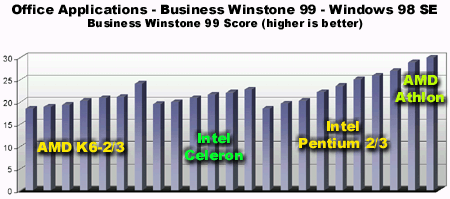Desktop CPU Comparison - September 99
by Anand Lal Shimpi on September 6, 1999 1:23 AM EST- Posted in
- CPUs
Benchmark Summary

Our favorite Winstone 99 score gives us a general breakdown of how each processor holds its own in your standard suite of business/office applications. The Athlon takes a 7% lead, clock for clock, over the Pentium III however when it comes to business applications, a 7% improvement in performance is pretty much the difference between conducting a search and replace in MS Word that takes 20 seconds, versus a "slower" 21 seconds. Basically, when it comes to Winstone 99 performance, although it is nice to say that you have the fastest Winstone 99 score on the planet, as long as you're at a decent level, you'll be fine.
For that reason, the Celeron and the K6-2/3 excel quite nicely in this benchmark. If you look at the above chart you'll notice that compared to the scaling of the Pentium II/III, the K6-2 does not scale that well with processor speed. This is primarily because most business applications try to fit entirely within the L2 cache, and processors with a larger, faster, L2 cache will experience a greater benefit in such applications. With the K6-2's L2 cache stuck operating at the FSB frequency (normally 95/100MHz), it isn't a surprise to see the Pentium II/III, whose L2 cache runs at 1/2 the core clock frequency (117 - 300MHz depending on the CPU), scale much better in this test.
The K6-3 performs much better in business application tests courtesy of its 256KB on-die L2 cache operating at clock speed and easily outperforms the equivalent Intel CPU on a clock for clock basis.
The Celeron's cache is already operating at such a high frequency that the benefit you get from moving from a Celeron 400 to a Celeron 500 (400MHz L2 to 500MHz L2) isn't as great as the benefit you get from upgrading from a Pentium II 400 to a 500MHz clock as the performance benefits tend to level off under the current architecture at the L2 cache frequencies the Celeron is pushing.
The true question here is, "What Winstone score is fast enough?" It's easy to quote a Winstone number and say that one processor is faster simply because it boasts a higher Winstone score, but to the user that's actually running the programs, he/she doesn't want to know whether a new CPU gets a 20.4 or a 20.6, they want to know how fast it actually is. Honestly, a Celeron 300 (un-overclocked) is more than enough for running Word, Excel, browsing the Internet and pretty much your average set of applications. Therefore, it is safe to say that the Business Winstone 99 sweet spot is around the 20 mark. If you're looking at a processor with a Winstone score of 10, then you'll definitely notice a difference when you move to something that brings in a 20, but if you're already at that 20 mark moving up to the 30 point mark the Athlon achieves most likely won't impress you all that much.
Unfortunately, the final buying decision is never that simple. If all you ran were the applications contained within the Business Winstone 99 test suite then you'd be just fine, however there are those addicting games that you love to play, as well as the image editing applications, the CAD/Drafting programs, the 3D rendering apps, and a handful of other, very CPU intensive programs that you can't live without that factor into your purchasing decision. Those factors aren't taken into account with a single Winstone 99 score, so let's move on...










0 Comments
View All Comments